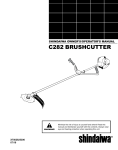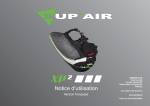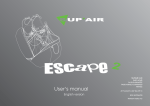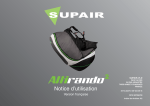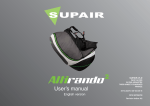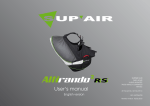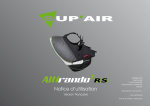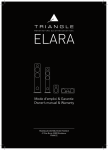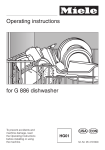Download User's manual
Transcript
SUPAIR-VLD User’s manual English version PARC ALTAÏS 34 RUE ADRASTÉE 74650 ANNECY CHAVANOD FRANCE 45°54.024’N / 06°04.725’ E RCS 387956790 Revision Indice 20130520 Thank you for choosing the XP2. We are proud to join you on your paragliding journey and common passion. SUP’AIR has been designing, producing and selling accessories for free flying activities since 1984. By choosing us you will benefit from almost thirty years of expertise, innovation and careful attention. Our philosophy is to continuously develop better products and maintain a high quality throughout put in Europe and the rest of the world. We trust that you will find this user’s manual comprehensive, explicit and hopefully pleasant to read. PLease read it carefully ! On our website www.supair.com, will update you on the latest information about this product. If you have any further questions, feel free to ask one of our retailers. And of course, the entire SUP’AIR team are at your disposal for additional answers through [email protected] We wish you many safe flights and happy landings. The SUP’AIR team 2 List of contents List of contents 3 Introduction4 Technical specifications 5 Size choice 6 Components7 Harness overview. 8 Backpack mode overall view. 9 Foot-rest installation. 10 Rescue parachute setup assembly. 11 Speed-Bag + optional cockpit installation 15 Speed-Bag + optional cockpit installation 16 Speed-Bag + optional cockpit installation. 17 Speed-Bag adjustment. 18 Speed-Bar ready ( Optional ). 19 Position setting 20 Flight behavior 23 Pre-Flight control. 24 Seating inside the harness with the adapted Speed-bag. 25 Take-off.26 Complements/Accessories28 Care29 Service Book 32 Pictures credits : SUP’AIR 3 Introduction Welcome to Cross-Country flying, performance, traveling and why not, the “bivouac” world ( hiking and flying ). The XP2 is the perfect product/tool to help you expend your horizons, whether they might be at your local site or during extreme mountaineering adventures. With its great comfort, a generous Air-bag and the reserve parachute pocket located beneath the seat, you will be equipped with a well rounded harness ready to thermal up anywhere on the globe. After reading this manual, we suggest a thorough hang-test before flying. N.B : Three important icons will help you when reading this manual Advice Caution ! Danger !! 4 Technical specifications Technical sheet Pilot size A Dorsal height (cm) Pilot’s weight B Backrest height adjustments (cm). Harness weight (+ carabiners + speed-bar). C Seat length (cm) D Seat width (cm) E Carabiners height (cm) F Hauteur du dos B Hauteur réglage de l'inclinaison du dossier C Longueur d'assise D Largeur d'assise F Impact damping system : Bumpair (Thickness) Certification Flight : tandem (Pilot- Passenger) Flight : acrobatic flying Take-off : Winching/towing. Quick-out carabiners compatibility F 155-170 cm 165-180 cm 4190 g L XL 175-195 195-205 cm cm 80-110 60-85 kg 70-95 kg kg 4290 g 4390 g 4490 g 72 39 49 35 44 39-53 75 40 51 35 44 39-53 Paragliding only Dorsal height (cm) Backrest height adjustments (cm). Seat length (cm) Seat width (cm) Carabiners height (cm) Carabiners to carabiner distance (cm). Impact damping system : Airbag (Volume) Distance entre les points M 50-70 kg Designed for Carabiners to carabiner disE Hauteur des points tance (cm). A S 64 38 47 33 44 39-53 68 38 48 33 44 39-53 Yes No EN 1651 - LTF possible No Yes Yes E A B D C This harness is delivered with two 30 mm Biners ( 138 g. for the set ). 5 Size choice Choosing your harness size is important. You will find here below a height/weight table to help you with your size choice. Nonetheless we advise you to try out the harness under a hanging device and in different sizes at one of our retailers in order to choose the correct size. For a complete retailers list, please click here : www.supair.com Size Weight 1m45 1m50 1m55 1m60 1m65 1m70 50 55 S S S S S S S 60 65 70 S S S S S S 1m75 1m80 1m85 M M M L M L L L L L L L M M M M 75 M M M 80 85 90 95 100 105 110 M M M M L L L L 1m90 1m95 2m 2m05 S XL XL XL XL S/M M L XL XL XL XL XL XL XL XL XL XL XL XL XL XL XL M/L L L/ XL XL 6 Components 4 1 2 FLIGHT Harness 2 Carbon plate XC SM 33x36 (size S-M) Carbon plate XC LXL 35x36 (size L-XL) 3 30 mm Aluminium self-locking biner 4 Reserve parachute handle (AX2-R) 5 Dyneema risers 6 Maillon Rapide ® Inox 6mm (x2) 7 O-Rings (x2) 8 Retractable foot-rest. Label 1 DIRECTION 3 5 8 6 7 9 Option 9 10 Double stage speed-bar 10 Speed-Bag XP² 7 Harness overview. This illustration will help you with your reading. 11 1 4 2 3 6 1 Self-locking chest strap buckle. 2 Safe-T-bar (Sup’Air patent A1-1832/981). 3 Self-locking leg strap buckle. 4 Chest strap width adjustment. 5 Leaning setting. 6 Shoulders straps adjustment. 7 Dorsal Air-bag with storage compartment. 11 8 7 9 5 8 10 12 5 9 Speed system pulleys. 10 Speed-bag reclining adjustment. 11 Hydration hose passage. 12 Air-Bag locking system. 13 Reserve parachute handle (AX2R). 13 6 Foot-rest buckles. 12 8 Backpack mode overall view. 4 5 2 1 6 1 Compression straps. 2 Elastic hiking pole lanyards. 3 Stretchable netted side pockets. 4 Adjustable straps. 8 5 2 3 9 10 load distribution Chest strap. 6 Hand-rest straps. 7 Chest strap adjustments. 8 Shoulder strap adjustments. 9 Belt pocket. 10 Lite Pack. 7 9 Foot-rest installation. The XP² is pre-equipped to accept a retractable foot-rest (A). A Push the elastic under the guide (C). C 2 Push the foot-rest strap through buckle (B) located at the front of the harness’s side skirt. Wrap and connect the elastic around the main strap while pushing it through buckle (D). B D D 3 1 B Adjust the foot-rest length during a hang-test and stow away the straps excess in the elasticated holder. 4 10 Rescue parachute setup assembly. Thank you for comprehensively reading the following ! We will recommend you to have your reserve parachute initially installed by someone competent and familiar with the procedure. 1. Make a lark’s head between the risers and the shoulder reserve parachute attachment points. Connecting the risers to the harness 2. Tighten the lark’s head securely. 1 2 1 Rescue parachute Dyneema or standard risers 2 Reserve parachute attachment points. 3. Neatly tuck away any excess riser under the flaps. 11 Connecting the handle to the rescue parachute’s deployment bag FLIGHT DIRECTION Label B l be La DIR EC HT N FL IG TIO A 1. Place side the loop and head knot the handle inmiddle webbing make a lark’s with the handle. 2. Fasten tightly the lark’s head knot and check the link’s integrity. The handle must be connected to the central loop, except for large reserve parachute ( use side loop ). Must be checked at the end of the installation procedure by gently pulling on the handle and make certain to disengage both safety loops held in place by the cable. Connecting the rescue to the Dyneema risers A XP² rescue parachute handle FLIGH T DIREC TION Label B C E Parachute folded according to manufacturers specification and in deployment bag. Dyneema risers DB Maillon Rapide ® Inox 6mm (x2) B E O-Rings (x2) D C 12 Installing the reserve parachute in its pocket. Thank you for comprehensively reading the following ! We will recommend you to have your reserve parachute initially installed by someone competent and familiar with the procedure. Adjustable reserve parachute pocket. With the inner flap setting positioned atop the velcro at the pocket center : the volume is reduced and will accept the reserve parachute X-Light. With the furthest pocket inner flap setting : The reserve parachute pocket vothe reserve parachute pocket offers maxilume is variable in size.You first mum capacity to accept standard solo paramust adjust its volume according to chutes. that of your reserve parachute size. Reserve parachute installation in its pocket. 1 1 / Insert the reserve parachute inside the harness parachute pocket by opening all the flaps. The POD must be positioned with the handle at the top with risers and lines at the bottom. Push the risers through the guiding sleeves ( the risers must be located behind the parachute ). 2 Push a piece of cord through the line loop #1 3 Push the cord through the grommets 2 and 3 and pull it to force the line loop through the grommets. 4 Push the handle’s yellow cable ( front section ) through line loop #1. Then delicately remove the cord from the underside of the loop. 13 5 Stow away the yellow cable’s end piece in its protective sleeve. 8 Push the handle’s yellow cable ( rear section ) through the elasticated line and delicately remove the cord. 6 7 Push the end of the cord through the elasticated loop #4, then guide it through the grommets #5 and #6 9 Pull the cord to guide the elasticated line through the grommets. 10 Close the Cordura flaps over the cable and push them through to the pocket’s top lid . Fold the Cordura flap over the handle and insert it underneath the handle’s flap to fasten it to the velcros. Upon setup completion, conduct an extraction sequence during a hang-test to verify that all works properly before duplicating the installation procedure again... 14 Speed-Bag + optional cockpit installation B E B D D E F G A H H J C I A Sliding system setup B Sliding system connection layout C Speed-bag B seat-pleat setup D Lateral low bridles E Speed-bag bridle tension adjustment F Lateral velcro strips G Velcro strips beneath the speed-bag H Carabiner connections I Speed-bag locking clips J Speed-bag locking clips Speed-bad seating plate Cockpit 15 Speed-Bag + optional cockpit installation 1 : Fasten the sliding system straps ( B ) to the buckles beneath the seat. B A A B 2 : Fasten the Velcro connections beneath the SpeedBag ( G ) in the receiving ends below the Air-Bag. 3 : Fasten the lateral right and left Velcro strips ( F ) under the harness Velcro flaps ( #10 – Page 8 ). G 16 Speed-Bag + optional cockpit installation. 4 : Go around the carabiners with the carabiners connectors ( H ). 5 : Speed-bag tension straps ( E ) : left side : unfasten the plastic buckle, push the cord through the grommet below the carabiner and make a “Girth hitch” knot again on the plastic buckle. 7 : Cockpit installation : engage the plastic buckles on the cockpit and harness’s right side ( beneath the carabiner ). 8 : Position the Velcro at the cockpit’s center. Front Back 6 : ( E ) : left side : unfasten the plastic buckle, push the cord through the grommet below the carabiner and through the Speed-Bag grommet, then make a “Girth hitch” knot again on the plastic buckle. Push the closing Speed-bag strap through the cockpit loop strap. In flight : the cockpit tilt can be locked in place using the retaining strap to be fastened behind the chest-strap. 17 Speed-Bag adjustment. 8 1 : During a hang-test, relax all the straps and seat inside the harness, without closing the Sped-bag. D E 2 : Adjust the leg length via the sliding system length adjustment ( B ). 3 : Adjust the lateral straps ( D ) B E 4 : By tensioning the top ( D ) more than the bottom ( B ) the Speed-bag will point upward. D B 5 : By tensioning the bottom ( B ) more than the top ( D ) the Speed-bag will point downward. 6 : Close the Speed-bag. Tighten if necessary the Speed-bag tension straps ( E ). The Speed-bag adjustment ( E ) must not have excess tension. The leg push must be taken over by the sliding system ( B ) and the side straps ( D ). E D B B Sliding system adjustment D Speed-bag lateral adjustment E Speed-bad tension adjustment 18 Speed-Bar ready ( Optional ). The XP2 is pre-equipped to receive most speed-bar systems found on today’s market. Within the SUP’AIR product line, the thin double-stage Speed-bar is best suited for being light and self-retractable. C A A Line. B Locking hook. C Elastic self-retractable speed-system. 1 2 4 Push the speed-bar line through D the the D ring. Push the speed-bar line between the outer webbing side and the harness skirt. 3 Push the speed-bar line through the pulley. 4 Attach the end of the speed-bar line to the crimped hook which is to be connected to the riser’s crimped hook. Adjust the line length and securely knot it. 5 Self-retracting speed-system: push the elastic cords through the D ring to connect them to the loop-line stitched on the inner far sides of the harness. 3 5 A 1 2 C D 19 Position setting All harness adjustments must be made prior the first flight during a hang-test session. It is of utmost importance to adopt a proper flying posture, check all basic adjustments and have easy access to in-flight adjustments. 1 Chest strap tightening adjustment finger-loop. 2 Chest strap loosening adjustment finger-loop. 3 4 6 Backrest tightening strap. 1 2 Backrest loosening strap. 3 5 6 5 Shoulder tightening strap. Shoulder loosening strap. 3 4 4 20 A Backrest tilt adjustment. Adjust the backrest angle by pulling or releasing the adjustment strap – pulling the black strap will offset the backrest angle from the vertical setting. The lumbar support can be modified by adjusting trim #5. B Shoulders straps adjustments. Tighten the shoulder straps by pulling the finger loop down. Pull up to release. The shoulder straps support, greatly helps the overall comfort level which should be set precisely. The correct tension between the side trims and the shoulder straps adjustments must be found. When adopting a reclined flying posture, the shoulder straps must enhance in-flight comfort by supporting the upper back area. tighten loosen loosen tighten C Chest strap adjustment. This adjustment is important for acting directly on the ABS and the harness’s overall stability. The tighter the more stable. The opposite is true while still enabling weight-shift steering. To tighten the chest strap: Place your left hand in front of and around the risers to grab the right self-locking carabiner. With the left arm, reduce the space between the risers and pull the finger-loop with your right hand to tighten the chest strap. To loosen the chest strap: Place your left hand in front of and pass the risers to grab the right self-locking Biner. With the left arm, shorten the distance between the risers and pull the finger-loop in the opposite direction to loosen the chest strap. 21 Reversible Harness / Backpack. How to turn the XP² from harness to backpack mode: 1 / Completely open the Air-Bag. 2 / Flip the Air-bag inside-out. 3 / Place the seat-plate vertically against the back wall - stow away your gear inside the newly made backpack. How to turn the XP² from backpack to harness mode: 1 / Completely loosen the backpack’s upper weight distribution straps or the Air-Bag will be pinched at the top. 2 / Completely unzip the Air-Bag. 3 / Empty the backpack’s content. 4 / Unfold the seat-pate toward the outside. 5 / Zip the Air-Bag and activate the pressure locking system located right onto the harness - designed to fully close the envelope and ensure its proper inflation. A 22 Flight behavior The XP2 is a safe and sound harness. Its ABS ( Anti Ballance System ) is very efficient, especially due to high crossed connection points. The stiffened but yet flexible backrest, the well padded shoulder straps give an excellent comfort level during long XC flights. This harness broadens the hiking and flying possibilities while being perfectly suited to tackle any local flying site. 23 Pre-Flight control. Conduct a thorough pre-flight check before each takeoff. • • • • • • Check the harness and carabiners integrity. Be certain for the reserve parachute pocket to be properly closed with its handle securely fastened in place. Check that your harness adjustments have not changed. Check the connexion risers / harness as well as the self-locking carabiners ( locked and secured ). Check your speed-bar system if your harness is equipped with one. Make certain to close all buckles, pockets and especially the Air-Bag zipper with its locking mechanism. Only after a thorough weather conditions analysis, can the decision to wether fly or not be taken, and outfit yourself with the harness. • Properly and securely fasten the thigh straps, Safe-T strap and chest strap buckles. • Double check that all buckles are fully locked and secured in place by pulling firmly on them. Be certain not to have any line, bridle, tab, fabric or miscellaneous material interfering with the buckles locking mechanism. • Be absolutely certain for the reserve parachute handle to work freely without anything impeding its proper functioning. 3 1 2 2 3 1 Thigh strap buckles. automatic Safe-T-Bar. Chest strap self-locking buckles. 24 Seating inside the harness with the adapted Speed-bag. • Fully lock the harness straps buckles ( 1, 2, 3 : leg-straps and Safe-T strap ). 3 1 2 Closing the Speed-bag : Continue by closing the two external flap buckles ( right side – #5 and 6 ). 4 1 During takeoff, the Speed-bag is located behind the legs. 5 6 Once air borne : pedaling backward must be done to catch the Speedbag before entering it. Note : buckle ( 6 ) can be closed once seated to facilitate the Speed-bag entry. 25 Take-off. Takeoff is simple and straight forward. The transition from running to seating is easy. If a bit more demanding then, raise your knees and push with your shoulders against the risers while wiggling your waist to help your body slide into the bottom of the seat. It is also possible when setting up, to tighten the leg straps slightly more to prevent them from riding up along your thighs while running. Never forced yourself into the harness with your toggles in hands. Excess tension on the brake lines, could slow the glider down and stall it. 26 In flight. Set the distance between the two carabiners according to the aerology and the manufacturer’s recommendations. The average distance / spacing for most gliders from the center of the right carabiner to the center of the left carabiner where the risers connect, is between 36 cm and 45 cm. Tightening the chest strap provides more stability but less harness piloting efficiency. Doing so, increases the risk of riser twisting. On the contrary, loosening the strap provides more efficiency but can be dangerous in turbulent aerology while increasing the risk of falling towards the collapsed side of your glider and without being able to efficiently correct the situation. Speed-bar use. We recommend a careful use of the speed-bar due of an increased risk of severe collapse. Please comprehensively read the glider manual. Landing Stretch your legs the and adopt an upright position in order to run and dissipate horizontal speed. Do not land whilst in the seated position, it is dangerous. WARNING : Frequents landings on the Airbag can damage the fabrics and stitches thus greatly reducing the Air-Bag’s integrity and efficiency. 27 Complements/Accessories We propose you optional accessories that combine perfectly to your XP² harness. Function Speed bar Code Code Front parachute pocket 100 g Soft speed bar 700 g Speed bar Double stage light speedbar for speedbag 43 g Speed bar Double stage light speedbar Harken pulley for speedbag 67 g Speed bag XP² ACCELSOUPLE Description All accessories relevant technical information comes with the product and are also accessible on our website at www.supair.com 28 Care Harness care. It is a good idea to wash your harness from time to time. We recommend using a soft solvent (such as mild soap). Use a brush and rinse thoroughly. Do not use chemicals such as caustic detergents or strong solvent for then may deteriorate the webbing, stitching and the harness fabric. The zip fasteners should be lubricated from time to time, using a silicon spray. If your harness gets wet, it is advisable to treat your self-locking buckles and carabiners with silicone grease from time to time. Storage and transport. When not in use, store your harness inside your paragliding rucksack, in a dry, cool and clean place, protected from UVs exposure. If wet, dry thoroughly before storing. During transport, keep the harness away from any mechanical or UV exposure (use a bag). Please avoid long transports in wet conditions. Longevity Independently of the pre-flight check, you have to open, unfold and repack your rescue parachute once every 6 months. Once every 2 years, you need to perform a complete harness check : Carbon seat plate : no crack or asperity. Webbings : (no excessive wear, unraveling or unwanted folds). Buckles and carabiners ( no structural cracks / works fine ). The threads composing the webbing and fabrics used in the XP² have been selected in order to ensure the best possible lightness/lifetime compromise. Nonetheless, in some conditions, after a long term exposure to UV and/or significant abrasion or exposure to chemicals, it is compulsory to have your harness checked in a certified repair centre. It is about your safety. These carabiners must never be used for anything else than paragliding (not for climbing, not towing, etc.). The carabiners must be replaced by a new set every 5 years. 29 Repairs In spite of using the highest quality materials, it is possible for your harness to eventually deteriorate through general use. If showing any signs of significant wear and tear, you should have it inspected and repaired if necessary, in a certified repair centre. SUP’AIR extends the possibility for products repairs beyond the end of the standard warranty period. Please contact us either by telephone or by E-mail [email protected] for details. Materials Fabrics CORDURA® RIPSTOP CORDURA® Recycling All our materials are selected for their technical and friendly characteristics. None are environmentally harmful. Most of our components are recyclable. If you deem your harness to have reached the end of its usefulness, you can separate all the plastic and metallic parts and apply up-to-date sorting recycling rules in effect in your community. If in doubt on how to proceed, we will advise you to contact your local organizations dealing with fabric recycling. Webbings Polyamide 20 mm (500DaN) Polyester 25 mm (1250 DaN) Environmental friendly practices. We highly recommend you to respect ing paragliding. Do not venture outside and do not disturb the environment as as the environment as much as possible while practicmarked trails, do not make unwanted or excessive noise a whole. Please be ecologically friendly wherever you are. 30 Warranty SUP’AIR takes the greatest care in its product line design and manufacturing. Offers a 5 years warranty from the purchase date against any manufacturing defect and product issue occurring during normal use. Any damage or degradation resulting from incorrect or abusive usage, abnormal exposure to aggressive elements, including, but not limited to; high temperature, intense and prolonged UV exposure, high humidity, excessive abrasion, etc... will void this warranty. Disclaimer Paragliding is an activity requiring skills, specific knowledge and sound judgement. Be sensible, learn in certified schools, be covered by an adequate insurance policy, as well as a flying with a valid up to date paragliding rating certification while making sure your skills match the flying conditions of the day. SUP’AIR cannot be held responsible for your paragliding decisions or activity choices. This SUP’AIR product has been designed exclusively for paragliding and can not be used in any activity such as skydiving, BASE jumping or any other activity. Pilot’s gear A certified head protection( helmet ), suitable footwear ( boots ), and adequate clothing must be used when paragliding. The use of a reserve parachute suitable for your weight and properly connected to your harness is also very important and highly recommended. 31 Service Book This section will help you keep track of your ALTIRANDO2 harness lifespan. Serial number : Purchase date Owner’s name Name and stamp of the shop Care Resale date Workshop’s name/ Buyer’s name Care Resale date Nom de l’atelier/de l’acheteur Care Resale date Workshop’s name/ Buyer’s name Care Resale date Workshop’s name/ Buyer’s name 32 SUPAIR-VLD PARC ALTAÏS 34 RUE ADRASTÉE 74650 ANNECY CHAVANOD FRANCE 45°54.024’N / 06°04.725’ E RCS 387956790

































